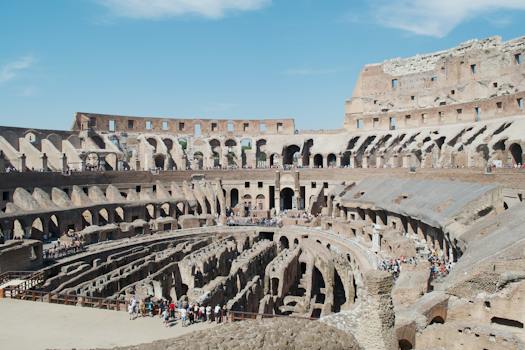

-
Table of Contents
Unleash the power of ancient warriors in The Ultimate Warriors of Ancient Rome: Unveiling the Gladiators.
Introduction
"The Ultimate Warriors of Ancient Rome: Unveiling the Gladiators" is a captivating exploration into the world of gladiators in ancient Rome. This book delves into the history, training, and lives of these skilled fighters, shedding light on their role in Roman society and the brutal spectacle of the gladiatorial games. Through meticulous research and vivid storytelling, the book offers a comprehensive and fascinating look at the gladiators, their weapons, their battles, and the enduring legacy they left behind.
The Rise of Gladiatorial Combat in Ancient Rome
The Rise of Gladiatorial Combat in Ancient Rome
Gladiatorial combat, a brutal and captivating form of entertainment, was a defining feature of ancient Rome. The origins of this blood sport can be traced back to the early Roman Republic, where it began as a religious ritual to honor the dead. Over time, however, it evolved into a spectacle that captivated the masses and became an integral part of Roman culture.
The earliest recorded gladiatorial combat took place in 264 BCE, during the funeral of a prominent aristocrat. This event, known as a munus, involved the staging of fights between slaves and prisoners of war. These early gladiatorial contests were relatively small-scale affairs, held in makeshift arenas and witnessed by a select few. However, as the popularity of the games grew, so did the demand for more elaborate and grandiose spectacles.
By the time of the Roman Empire, gladiatorial combat had become a highly organized and regulated form of entertainment. The emperors recognized the potential of these games to win the favor of the people and solidify their power. They invested vast sums of money in constructing magnificent amphitheaters, such as the Colosseum, which could accommodate tens of thousands of spectators.
Gladiators were typically slaves or prisoners of war who had been trained to fight in the arena. They were often purchased by wealthy individuals or the state and were subjected to rigorous training to prepare them for their deadly encounters. The life of a gladiator was one of constant danger and uncertainty, as they faced the very real possibility of death with each fight.
The gladiators were divided into different classes, each with its own distinctive fighting style and weaponry. The most famous of these were the retiarii, who fought with a trident and a net, and the secutores, who were heavily armed and armored. Each class had its own set of rules and strategies, which added to the excitement and unpredictability of the fights.
The gladiatorial games were not just about bloodshed and violence; they were also a means of social control. The spectacles served as a powerful tool for the ruling elite to assert their dominance and maintain order among the masses. By providing the people with a thrilling and awe-inspiring spectacle, the emperors were able to distract them from their everyday struggles and grievances.
The popularity of gladiatorial combat reached its peak during the reign of Emperor Commodus in the late 2nd century CE. Commodus, a notorious megalomaniac, was obsessed with the games and often participated in them himself. He would enter the arena dressed as a gladiator and engage in staged fights, often against disabled or inexperienced opponents. This further fueled the public's fascination with gladiatorial combat and solidified its place as a central aspect of Roman culture.
In conclusion, the rise of gladiatorial combat in ancient Rome was a complex phenomenon that evolved from a religious ritual to a grand spectacle. The games served as a means of entertainment, social control, and political propaganda. The gladiators themselves were the ultimate warriors, trained to fight to the death for the amusement of the masses. While the games may seem barbaric to modern sensibilities, they were an integral part of Roman society and left an indelible mark on the history of the ancient world.
The Training and Skills of Ancient Roman Gladiators

The Training and Skills of Ancient Roman Gladiators
In the grand arenas of ancient Rome, gladiators were the ultimate warriors. These skilled fighters captivated audiences with their daring feats and deadly combat. But what made these gladiators so formidable? It all came down to their rigorous training and honed skills.
The training of a gladiator was a grueling process that began from a young age. Boys as young as eight years old were selected for their potential as future gladiators. These boys were then sent to specialized training schools known as ludi, where they would spend years honing their skills.
At the ludi, the young gladiators underwent a strict and disciplined training regime. They were taught the art of combat, learning various fighting techniques and mastering a wide range of weapons. The gladiators were trained in the use of swords, shields, spears, and even nets. They were taught how to fight both on foot and on horseback, ensuring they were versatile and adaptable in the arena.
The training sessions were intense and physically demanding. The gladiators would engage in rigorous exercises to build strength, endurance, and agility. They would practice their fighting techniques repeatedly, perfecting their moves and reactions. The gladiators were also trained in the art of strategy, learning how to read their opponents and exploit their weaknesses.
But training wasn't just about physical prowess. Gladiators were also expected to possess a certain level of showmanship. They had to entertain the crowds with their skills and charisma. They were taught how to engage the audience, how to command attention, and how to create a spectacle in the arena. This aspect of their training added an element of theatricality to their performances, making them not just warriors, but also performers.
The gladiators' training was not limited to the ludi. They would also engage in mock battles and sparring sessions to further refine their skills. These practice fights allowed them to test their abilities against other gladiators and learn from each other. It was in these sessions that they would develop their combat strategies and learn how to anticipate their opponents' moves.
The gladiators' training was not without risks. Despite the precautions taken, injuries were common during training. Broken bones, cuts, and bruises were a regular part of a gladiator's life. However, these injuries were seen as a testament to their dedication and resilience. They were badges of honor that showcased their commitment to their craft.
The training of a gladiator was a lifelong pursuit. Even after they had completed their initial training, gladiators continued to practice and refine their skills. They would often participate in public exhibitions and competitions to showcase their abilities. These events allowed them to gain fame and recognition, as well as provide an opportunity for further training and improvement.
In conclusion, the training and skills of ancient Roman gladiators were what made them the ultimate warriors of their time. From a young age, these gladiators underwent rigorous training in combat techniques, weapons mastery, and showmanship. Their training was physically demanding and required discipline, strength, and agility. But it was through this training that they became the fearsome and captivating fighters that enthralled audiences in the grand arenas of ancient Rome.
The Life and Legacy of Famous Gladiators in Ancient Rome
The Life and Legacy of Famous Gladiators in Ancient Rome
Gladiators, the ultimate warriors of ancient Rome, have captivated the imaginations of people for centuries. These skilled fighters, who entertained the masses with their deadly combat, left behind a legacy that continues to intrigue and inspire. In this article, we will delve into the lives of some of the most famous gladiators in ancient Rome, exploring their origins, training, and the impact they had on Roman society.
One of the most renowned gladiators in history was Spartacus. Born in Thrace, a region in modern-day Bulgaria, Spartacus was captured by the Romans and sold into slavery. He was trained as a gladiator and fought in the arenas of Rome. However, Spartacus had a burning desire for freedom, and in 73 BCE, he led a massive slave revolt known as the Third Servile War. Spartacus and his followers, numbering in the tens of thousands, fought against the Roman legions for two years before ultimately being defeated. Although Spartacus did not achieve his goal of liberating all slaves, his rebellion left an indelible mark on Roman society, highlighting the inherent injustices of the system.
Another famous gladiator was Commodus, who became Emperor of Rome in 180 CE. Commodus, known for his love of gladiatorial combat, often participated in the games himself. He would enter the arena as a gladiator, facing off against other fighters. This practice was highly unusual for an emperor, as it was considered beneath their dignity. Commodus relished the adoration of the crowd and reveled in his victories. However, his obsession with gladiatorial combat and neglect of his duties as emperor ultimately led to his downfall. Commodus was assassinated in 192 CE, marking the end of the Antonine dynasty.
While Spartacus and Commodus were famous for their exploits in the arena, there were also gladiators who achieved fame through their exceptional skills and victories. One such gladiator was Flamma, a Syrian who fought in the first century CE. Flamma was known for his incredible endurance and resilience, having survived over twenty battles. Despite being offered freedom on multiple occasions, Flamma chose to remain a gladiator, driven by his love for combat. His dedication and skill earned him the title of "the man who refused to die." Flamma's story serves as a testament to the allure and allure of the gladiatorial lifestyle.
The legacy of gladiators extends beyond their individual stories. Gladiatorial combat was a central aspect of Roman culture, serving as a form of entertainment and a means of social control. The games were a spectacle that brought people from all walks of life together, transcending social boundaries. Gladiators, with their displays of strength, skill, and bravery, became symbols of Roman ideals such as honor and courage. Their popularity and influence were such that even emperors sought to associate themselves with the gladiatorial world.
In conclusion, the lives and legacies of famous gladiators in ancient Rome continue to fascinate us to this day. Spartacus, Commodus, and Flamma are just a few examples of the countless warriors who captivated the Roman populace with their deadly skills. Their stories shed light on the harsh realities of life in ancient Rome and the enduring appeal of gladiatorial combat. The gladiators' impact on Roman society, both as individuals and as symbols, cannot be overstated. They remain a testament to the power of human resilience and the complexities of ancient civilizations.
Q&A
1. What is "The Ultimate Warriors of Ancient Rome: Unveiling the Gladiators" about?
"The Ultimate Warriors of Ancient Rome: Unveiling the Gladiators" is a book that explores the history and culture of gladiators in ancient Rome.
2. Who is the author of "The Ultimate Warriors of Ancient Rome: Unveiling the Gladiators"?
The author of "The Ultimate Warriors of Ancient Rome: Unveiling the Gladiators" is Robert C. Knapp.
3. What can readers expect to learn from "The Ultimate Warriors of Ancient Rome: Unveiling the Gladiators"?
Readers can expect to learn about the origins of gladiatorial combat, the different types of gladiators, their training and equipment, as well as the social and political significance of gladiatorial games in ancient Rome.
Conclusion
In conclusion, "The Ultimate Warriors of Ancient Rome: Unveiling the Gladiators" provides a comprehensive exploration of the gladiators in ancient Rome. The book delves into their origins, training, and the various types of gladiatorial combat. It also examines the social and cultural significance of gladiators in Roman society, shedding light on their role as both entertainers and symbols of power. Through meticulous research and engaging storytelling, the book offers valuable insights into the fascinating world of ancient Roman gladiators.












